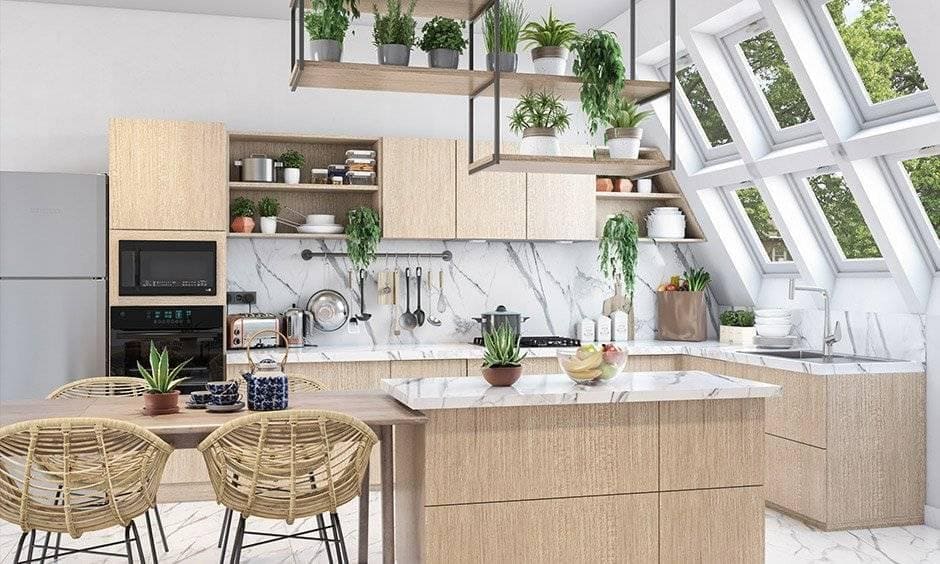Eco-friendly kitchen renovations enable homeowners to create a stylish, functional space while protecting the planet. By using sustainable materials, energy-efficient appliances and water-saving fixtures, you can reduce waste and improve indoor air quality. Likewise, smart appliances, renewable energy and responsible finishes can help you save money and cut your carbon footprint. Modern design makes it easy to combine durability with eco-conscious choices.
Designing Stylish and Eco-Friendly Kitchens
The rise of minimalist and eco-friendly lifestyles is influencing consumer purchasing decisions. Homeowners increasingly desire kitchens that look appealing and reduce environmental impact. Opting for eco-friendly alternatives helps minimize waste and promotes ethical sourcing. By using sustainable materials and energy-efficient appliances, homes can become healthier and more comfortable.
Innovative materials and technologies are making sustainable kitchens both stylish and long-lasting. Homeowners can enjoy high quality without compromising their eco-conscious values. Implementing energy-efficient strategies — such as passive heating, cooling and renewable energy sources — can lead to cost savings and a smaller carbon footprint.
Kitchens are lively areas brimming with various energy-consuming appliances and specialized work surfaces. Thus, creating a green kitchen involves more than the straightforward setup of appliances and systems for saving energy and water. A genuinely sustainable kitchen begins from the ground up, incorporating everything from eco-friendly cabinetry to nontoxic finishes and adhesives.
The cutting-edge in energy-efficient and sustainable kitchen design is an evolving domain that includes innovations in building design, appliance efficiency, renewable energy integration, carbon neutrality and smart home technology.
Choosing Sustainable Materials
Building a sustainable kitchen begins with selecting the right materials. Recycled steel is strong, fire-resistant and perfect for framing, beams and structural supports. Using recycled steel saves resources and cuts carbon emissions. Similarly, recycled concrete repurposes old concrete into durable materials for foundations, floors and landscaping. Both materials are versatile, sustainable and support circular construction practices.
Leftover stone scraps from recycled granite preserve its natural beauty while reducing quarry waste. Manufacturers combine paper fibers with plant-based resins to create recycled paper countertops, producing lightweight, durable surfaces that resist heat and scratches. Bamboo grows rapidly and renews itself easily, making it perfect for flooring, cabinets, wall cladding and decorative accents. Its strength, flexibility and natural pest resistance make it highly versatile.
FSC-certified wood comes from responsibly managed forests, offering the same durability and beauty as traditional wood while promoting forest conservation. Plant-based polyurethane, made from renewable oils such as soy or caster, offers durable insulation, coatings and adhesives with a lower carbon footprint. Each material can help reduce reliance on fossil fuels and create a healthier, more sustainable kitchen.
Low-volatile organic compounds (VOC) paints reduce harmful emissions, improving indoor air quality and occupant health. Made with water- or plant-based solvents, they lower environmental impact while providing the same colors and durability as traditional paints. Using low-VOC paints supports green building standards and promotes healthier indoor spaces without compromising performance or aesthetics.
Quartz countertops can significantly enhance the appearance of your kitchen and bathrooms. Manufacturers craft these stylish surfaces from durable materials that need minimal upkeep. You can choose from a wide variety of designs and colors. Although quartz resists stains and is easy to maintain, it’s ideal to clean countertops regularly. Allowing spills and dirt to linger on quartz can cause discoloration and dull its shine.
Utilizing Renewable Energy Solutions and Smart Home Systems
Renewable energy can play a key role in modern kitchens. Solar thermal systems provide hot water for domestic use and can also supplement kitchen appliances. Photovoltaic (PV) systems, such as solar panels, can supply electricity directly to the kitchen or the entire household. This reduces reliance on the grid.
Energy storage systems help make renewable energy more practical and accessible. Thermal energy storage often utilizes materials, such as phase-change materials (PCMs), to store excess heat for later use. Electric batteries can store surplus electricity from renewable sources for use during periods of peak demand.
Heat pumps offer solutions for heating, cooling and hot water. Integrated heat pumps utilize temperature differences between the inside and outside of the kitchen to provide energy-efficient heating and hot water. Reversible heat pumps can switch between heating and cooling modes, sometimes providing refrigeration and hot water simultaneously.
Water heaters can use up to 340% more energy than fridges. Since electricity is a major contributor to carbon emissions, improving water heater efficiency is essential. Eco-friendly refrigerants also reduce environmental impact.
Many manufacturers still use hydrofluorocarbons (HFCs), which are 1,000 to 9,000 times more potent than carbon dioxide. Choosing a fridge that does not use HFCs can be more environmentally beneficial than one that simply uses less energy.
Innovative technology enables households to manage their energy use more efficiently. Automated systems can control appliances to reduce unnecessary consumption, while smart meters and energy management systems allow households to track and optimise energy usage.
Ensuring Smart Water Management Strategies
Water conservation is essential to creating an eco-friendly kitchen. Modern technologies now make it easier for homeowners to monitor and manage water use in real time. This can reduce waste and save money.
Smart water meters track water consumption from various taps and appliances, alerting you to leaks or unusual usage patterns. Some systems connect to smartphone apps, allowing you to check your water usage from anywhere and receive notifications if a faucet or dishwasher is using more water than usual.
Leak detection systems can identify issues early, preventing damage and unnecessary water waste. Advanced setups may even utilize sensors to measure flow and temperature, providing you with detailed insights into how your kitchen uses water.
Automated water-saving strategies can work alongside low-flow faucets, efficient dishwashers and greywater recycling systems. These technologies ensure that you use only what you need, preheat incoming water with heat recovery systems and repurpose greywater for non-drinking uses, such as irrigation.
By combining intelligent monitoring, leak detection and water-efficient fixtures, your kitchen can significantly reduce water consumption while promoting an eco-conscious home.
Improving Indoor Air Quality and Ventilation
Indoor air pollution poses serious health risks because contaminants like ozone, particulate matter, formaldehyde, and carbon dioxide can harm the respiratory, neurological and cardiovascular systems. Exposure to these pollutants can lead to long-term health problems.
To manage indoor air quality effectively, address the sources of pollutants and ensure proper ventilation systems are in place. Sources can include building materials, furniture and electronics, as well as pollution from cooking, cleaning and outdoor activities. Adequate ventilation — whether natural, mechanical or a combination of both — is essential for reducing pollutant levels.
While mechanical ventilation ensures consistent air quality, it also raises energy consumption, necessitating a balance between energy efficiency and maintaining healthy indoor air. Adaptive ventilation strategies that address multiple pollutants simultaneously enhance air quality and reduce energy consumption, providing a practical solution for modern buildings.
Low-flow fixtures, such as faucets and dishwashers, reduce water use while maintaining performance. This can lower the energy needed to heat water. Water recycling systems purify and reuse greywater for nonpotable purposes in the kitchen, further conserving resources.
Heat recovery ventilators and greywater heat recovery systems capture energy from exhaust air or warm wastewater. They use this energy to preheat incoming water, reducing energy waste and boosting overall efficiency.
Budgeting for Eco-Friendly Renovations and Accessing Incentives
Federal initiatives offer a range of financial incentives to promote energy efficiency and renewable energy in residential and commercial settings. These initiatives provide grants, loans, loan guarantees and tax credits to support the purchase of energy-efficient appliances, heating and cooling systems, insulation and lighting. They also help fund renewable energy installations, such as solar panels and geothermal systems.
The Department of Energy manages a wide range of programs supporting the research, development, and use of renewable and efficient technologies. Other organizations — such as the Department of Agriculture (USDA) and the Treasury — provide incentives for rural energy initiatives, biofuels and energy-efficient home upgrades. Additional programs are available through HUD, SBA, Fannie Mae, the Department of Veterans Affairs and others, catering to homeowners, businesses and public entities alike.
Initiatives have progressed through significant legislation, including the Energy Policy Act of 2005 and the Energy Independence and Security Act of 2007. Each piece of legislation has expanded or updated incentives to match evolving technology, energy needs and environmental goals across all sectors.
The eligibility criteria for these incentives are broad. Homeowners, businesses, schools, local governments and rural communities can access programs supporting solar energy, advanced heating and cooling systems, and energy-efficient appliances. These programs also cover building materials and electrification projects. By strategically utilizing federal incentives, property owners can lower renovation costs, improve long-term energy efficiency and support national sustainability objectives.
Making Your Kitchen a Model of Sustainability
A sustainable kitchen combines beauty with functionality. By selecting nontoxic materials, energy-efficient appliances and water-conserving solutions, you can lessen your environmental footprint. Intelligent design and mindful waste management can lead to significant improvements. Government incentives help make eco-friendly renovations more accessible and budget-friendly. Turn your kitchen into a healthy, efficient and genuinely sustainable space.





